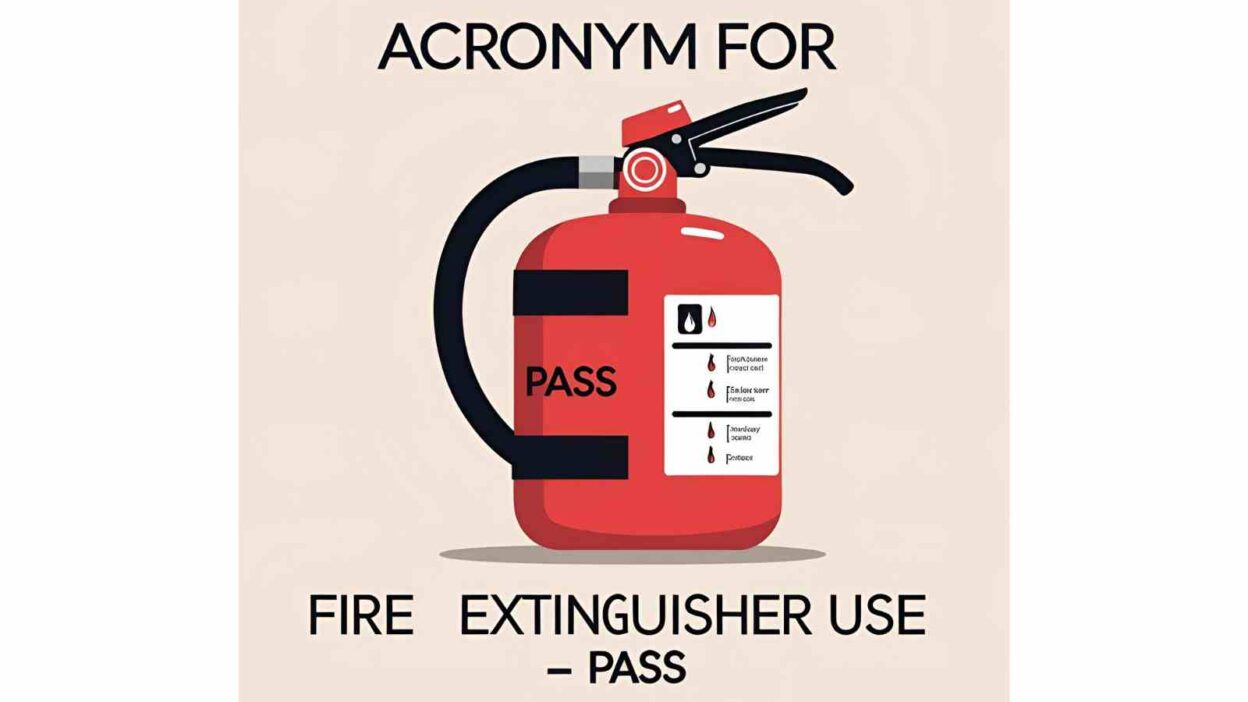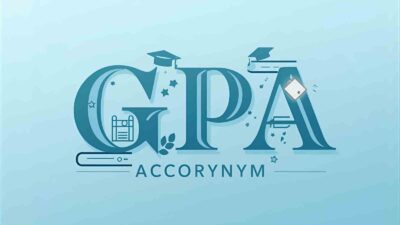When it comes to fire safety, even the smallest details can save lives. That’s why the acronym for fire extinguisher use plays such a critical role in training. Acronyms are memory tools that help us recall complex steps quickly — especially in stressful, high-pressure situations where panic can make people freeze.
The most famous acronym in this area is PASS — Pull, Aim, Squeeze, Sweep. It’s simple, widely taught, and OSHA-approved. But here’s the catch: PASS isn’t the only acronym out there. Trainers, workplaces, schools, and even community safety programs have developed alternative fire extinguisher acronyms to make the process easier for different audiences.
This guide will give you 30 alternatives to PASS, along with clear explanations, examples, and tips on when to use them. You’ll also learn the subtle emotional and cultural contexts that make one acronym more effective than another.
What Does PASS Stand For in Fire Safety?
Before diving into the alternatives, let’s revisit the original:
- Pull the pin
- Aim at the base of the fire
- Squeeze the handle
- Sweep side to side
This acronym is easy to remember and highly effective. However, some trainers also compare PASS vs RACE (another acronym: Rescue, Alarm, Confine, Extinguish) to emphasize overall fire response.
👉 Key difference: PASS focuses on how to use a fire extinguisher, while RACE focuses on overall fire response strategy.
Why Alternatives Exist
- Audience Fit → Kids, seniors, or employees may respond better to different words.
- Emotional Tone → Some acronyms reduce panic (CALM), others boost confidence (HERO).
- Cultural Sensitivity → Humor may work in schools but not in hospitals.
- Training Style → Workplaces often prefer structured ones (PLAN), while public campaigns may use motivational ones (RISE).
Quick Reference Table of Acronyms
| Acronym | Meaning | Best For |
|---|---|---|
| PASS | Pull, Aim, Squeeze, Sweep | Standard workplaces, OSHA training |
| PALS | Pull, Aim, Level, Sweep | Children’s fire safety |
| SAFE | Stand, Aim, Fire, Extinguish | Offices, hospitality |
| FAST | Find, Aim, Squeeze, Tackle | Military, aviation |
| FIRE | Find, Initiate, Release, Extinguish | Schools, awareness campaigns |
| ACTS | Aim, Control, Tackle, Sweep | Corporate drills |
| CALM | Check, Aim, Level, Manage | Healthcare, elderly |
| ALERT | Aim, Level, Engage, Release, Tackle | Public spaces |
| STOP | Stand, Target, Operate, Protect | Posters, awareness |
| HERO | Hold, Engage, Release, Overcome | Kids, youth programs |
| … | … | … (see detailed list below) |
(Full details of all 30 follow in the next section)
30 Alternatives to the Acronym for Fire Extinguisher Use
Here’s the complete list. Each includes: meaning, example, and when to use.
1. PASS – Pull, Aim, Squeeze, Sweep
Example: “The instructor said, remember PASS — it’s your first line of defense.”
When to use: Standard safety training, OSHA compliance.
2. PALS – Pull, Aim, Level, Sweep
Example: “Kids loved learning PALS — because friends help friends stay safe.”
When to use: Fire safety for children.
3. SAFE – Stand, Aim, Fire, Extinguish
Example: “Our office posters displayed SAFE steps to calm staff.”
When to use: Corporate, hospitality industry.
4. FAST – Find, Aim, Squeeze, Tackle
Example: “In emergencies, firefighters told us to act FAST.”
When to use: High-stress jobs (aviation, military).
5. FIRE – Find, Initiate, Release, Extinguish
Example: “The FIRE acronym made students laugh but remember it.”
When to use: Schools, awareness campaigns.
6. ACTS – Aim, Control, Tackle, Sweep
Example: “During the drill, the trainer reminded us: safety ACTS.”
When to use: Corporate training workshops.
7. CALM – Check, Aim, Level, Manage
Example: “CALM reassured hospital staff not to panic.”
When to use: Hospitals, elderly care.
8. ALERT – Aim, Level, Engage, Release, Tackle
Example: “Posters in airports featured ALERT in big red letters.”
When to use: Malls, airports, public venues.
9. STOP – Stand, Target, Operate, Protect
Example: “STOP was easy to include in general safety campaigns.”
When to use: Public safety posters.
10. HERO – Hold, Engage, Release, Overcome
Example: “Kids wanted to be the HERO of the day.”
When to use: Children and youth training.
11. CLAP – Check, Level, Aim, Press
Example: “Teachers clapped after drills to reinforce CLAP.”
When to use: Kindergarten fire drills.
12. RASE – Remove pin, Aim, Squeeze, Extinguish
Example: “Our factory manual taught RASE instead of PASS.”
When to use: Industrial environments.
13. STAY – Stand, Target, Activate, Yaw
Example: “The nurse reminded us: STAY calm, STAY safe.”
When to use: Hospitals, shelters.
14. SAVE – Stand, Aim, Vent, Extinguish
Example: “SAVE your workplace by learning this acronym.”
When to use: Awareness posters, NGOs.
15. FIST – Find, Initiate, Squeeze, Tackle
Example: “Military cadets practiced fighting fire with a FIST.”
When to use: Army, police academies.
16. CARE – Check, Aim, Release, Extinguish
Example: “Nurses preferred CARE as it connected to compassion.”
When to use: Healthcare training.
17. EASY – Engage, Aim, Squeeze, Yaw
Example: “Community programs said using an extinguisher is EASY.”
When to use: General awareness drives.
18. SHOT – Stand, Hold, Operate, Tackle
Example: “Security teams learned to take a SHOT at fire.”
When to use: Security or law enforcement.
19. COOL – Check, Operate, Overcome, Level
Example: “Teen volunteers enjoyed COOL — stay cool, fight fire.”
When to use: Youth training.
20. PLAN – Pull, Level, Aim, Neutralize
Example: “Managers liked PLAN — safety needs strategy.”
When to use: Corporate fire safety.
21. TACT – Target, Activate, Control, Tackle
Example: “Police recruits drilled on using TACT.”
When to use: Tactical, emergency services.
22. RISE – Release pin, Initiate, Sweep, Extinguish
Example: “The trainer said: we RISE above danger.”
When to use: Motivational training.
23. GIFT – Grip, Initiate, Fire, Tackle
Example: “Charity drives shared fire safety as a GIFT.”
When to use: Nonprofit safety events.
24. TEAM – Target, Engage, Activate, Manage
Example: “TEAM reminds us safety is not individual.”
When to use: Workplace safety.
25. HOLD – Hold, Operate, Level, Direct
Example: “Remember HOLD steady when aiming.”
When to use: Factories, workshops.
26. LIFT – Locate, Initiate, Fire, Tackle
Example: “LIFT your extinguisher, LIFT safety.”
When to use: Community awareness.
27. TAME – Target, Activate, Manage, Extinguish
Example: “Fire is wild, but we can TAME it.”
When to use: Campaign slogans.
28. WISE – Watch, Initiate, Squeeze, Extinguish
Example: “Be WISE — don’t panic.”
When to use: Schools, colleges.
29. SURE – Stand, Use, Release, Extinguish
Example: “Confidence comes from being SURE.”
When to use: Confidence-building sessions.
30. END – Engage, Neutralize, Defeat
Example: “We END the fire before it spreads.”
When to use: Motivational slogans.
Choosing the Right Acronym
- Workplaces: PASS, RASE, PLAN
- Children: PALS, HERO, CLAP
- Healthcare/Elderly: CALM, CARE, WISE
- Military/Security: FAST, FIST, TACT, SHOT
- Public Campaigns: RISE, SAVE, TAME
👉 Always balance clarity, tone, and audience needs. For example, hospitals prefer calm language, while the military benefits from strong action-based acronyms.
FAQs
Q1. What does PASS stand for in fire safety?
PASS means Pull, Aim, Squeeze, Sweep — the standard acronym for fire extinguisher use.
Q2. What is the difference between PASS and RACE in fire safety?
PASS is about using an extinguisher, while RACE (Rescue, Alarm, Confine, Extinguish) is about responding to fire overall.
Q3. Why are acronyms important in fire extinguisher training?
They improve memory retention, reduce panic, and provide clear step-by-step guidance.
Q4. Can children use acronyms like PASS?
Yes, but child-friendly versions like PALS or HERO are easier for them to understand.
Q5. Which acronym is OSHA-approved?
PASS is the recognized standard by OSHA and most fire safety bodies.
Conclusion
The acronym for fire extinguisher use may start with PASS, but that’s just the beginning. Whether you choose CALM for hospitals, HERO for kids, or TACT for security forces, acronyms are powerful tools to make safety training memorable, relatable, and effective.
By tailoring the right acronym to the right audience, you don’t just teach — you empower people to act confidently in an emergency.




